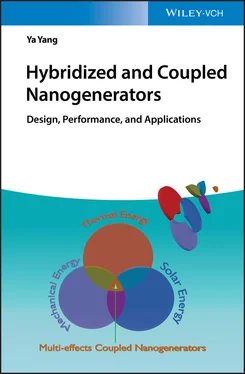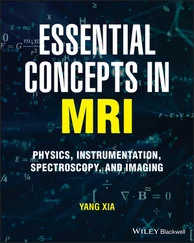Ya Yang - Hybridized and Coupled Nanogenerators
Здесь есть возможность читать онлайн «Ya Yang - Hybridized and Coupled Nanogenerators» — ознакомительный отрывок электронной книги совершенно бесплатно, а после прочтения отрывка купить полную версию. В некоторых случаях можно слушать аудио, скачать через торрент в формате fb2 и присутствует краткое содержание. Жанр: unrecognised, на английском языке. Описание произведения, (предисловие) а так же отзывы посетителей доступны на портале библиотеки ЛибКат.
- Название:Hybridized and Coupled Nanogenerators
- Автор:
- Жанр:
- Год:неизвестен
- ISBN:нет данных
- Рейтинг книги:3 / 5. Голосов: 1
-
Избранное:Добавить в избранное
- Отзывы:
-
Ваша оценка:
- 60
- 1
- 2
- 3
- 4
- 5
Hybridized and Coupled Nanogenerators: краткое содержание, описание и аннотация
Предлагаем к чтению аннотацию, описание, краткое содержание или предисловие (зависит от того, что написал сам автор книги «Hybridized and Coupled Nanogenerators»). Если вы не нашли необходимую информацию о книге — напишите в комментариях, мы постараемся отыскать её.
Hybridized and Coupled Nanogenerators — читать онлайн ознакомительный отрывок
Ниже представлен текст книги, разбитый по страницам. Система сохранения места последней прочитанной страницы, позволяет с удобством читать онлайн бесплатно книгу «Hybridized and Coupled Nanogenerators», без необходимости каждый раз заново искать на чём Вы остановились. Поставьте закладку, и сможете в любой момент перейти на страницу, на которой закончили чтение.
Интервал:
Закладка:
2.3.4 Applications
Wind is one of the familiar energy sources in the surrounding environment. WD‐TENGs can effectively harvest wind energy, converting mechanical energy to electrical energy. Owing to their advantages such as small scale, low cost, and easy fabrication, WD‐TENGs can be used in many fields, especially for portable electronics. With the tremendous increase in low power devices, combining TENGs with other devices is vitally important because the combined systems can eliminate dependence for external energy storage by harvesting mechanical energy in the environment.
2.3.4.1 Self‐Powered Printer
The printer is a common office equipment, and has been used widely in offices, schools, and supermarkets. However, immobility and high energy consumption are two main drawbacks of current printers. Therefore, Chen et al. developed a self‐powered printer system, which consists of a simple handheld printer and a transparent TENG. The handheld system was assembled with a syringe and an acrylic holder [51]. The TENG could harvest wind energy, and then generate electrical energy to power the printer.
To provide unidirectional voltages to power the printer, a rectifier was used to adjust the primary output voltages generated by the TENG. Figure 2.14a shows the working mechanism of the self‐powered printer system. The wind‐driven TENG system can generate a DC voltage of about 130 V under a wind speed of 20 m/s, which could form an electric field between the nozzle and the copper sheet. The droplet surface could accumulate positive charges under this condition. The droplet was exposed to gravity and the downward electric field force, and could fall toward the copper sheet when the downward collective force was larger than the van der Waals force between the nozzle and the color ink droplet. The separating process of the droplet was illustrated in Figure 2.14b–d. Figure 2.14e shows that the letters of "TENG" were successfully color printed by the self‐powered printer system. In addition, this system can be used to fabricate a flexible conductive path comprised by printing Ag nanowire suspension, as shown in Figure 2.14f. A light‐emitting diode fixed on the path can be lightened by applying a 2.5 V DC voltage. Figure 2.14g shows a handheld printing system, which can be powered by human mouth‐blown air. In this condition, the value of output voltage was about 55 V. The handheld printing system can be used to print discrete points by harvesting mouth‐blown wind energy, as shown in Figure 2.14h.
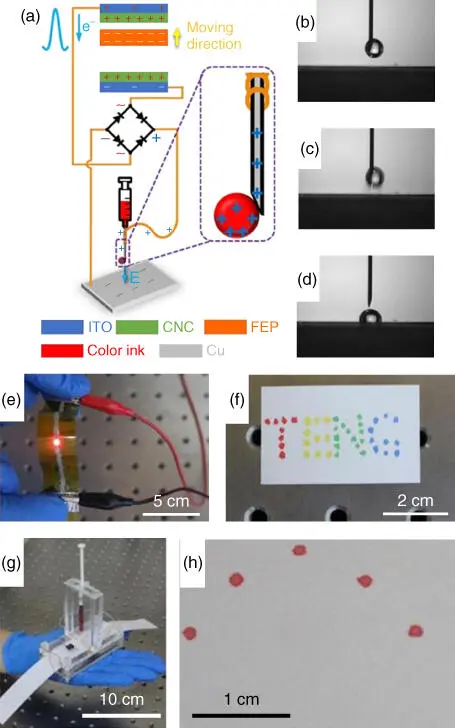
Figure 2.14The working principle and a photograph of the fabricated self‐powered printer. (a) The schematic diagram of the printer working principle. (b–d) Images of the separating process of the ink droplet. (e) The conductive circuit was printed by the printer and Ag nanowire suspension. (f) The letters were printed by the printer. (g) A photograph of the handheld printing system. (h) The curve printed by harvesting mouth‐blown wind energy.
Source: Reproduced with permission from Chen et al. [51]. Copyright 2018, Elsevier.
2.3.4.2 Wind Gauging System
A wind vector sensor system, which can detect wind speed and direction, has been widely used in weather forecasting. Traditionally, wind sensors need external power sources or conventional batteries, which limit their long‐term work. Wang et al. developed a self‐powered wind sensor system based on an anemometer TENG and a wind vane TENG. This system can simultaneously detect wind speed and direction [40]. Yang et al. developed a self‐powered wind vector sensor system based on four TENGs [32]. To detect wind flows from multiple directions, four independent wind‐driven TENGs were fixed along four directions, as shown in Figure 2.15a. Figure 2.15b shows the external circuit diagram. The output current signals of the wind‐driven TENGs could be enhanced by increasing the wind speeds. Thus, by measuring the current signals, the wind speeds could be in turn calculated, as shown in Figure 2.15c. The output voltage peaks have small fluctuations, which can be independently used to confirm the wind direction ( Figure 2.15d). The output voltage signals were connected to 16 channels, forming a mapping figure. When no wind flowed along the four directions, the value of the output voltage was 0, and when the wind flowed along one direction, the wind direction can be confirmed by observing the mapping figures, as shown in Figure 2.15e–h.
2.3.4.3 Polarization of Ferroelectric Materials
Ferroelectric materials, such as BiFeO 3, Bi 2FeCrO 6, and BaTiO 3, have been widely used in photovoltaic devices due to their abnormal photovoltaic effect. Usually, these materials need a polarization process, which could induce most of the domains along a fixed direction by applying a high external electric field. Conventional polarization apparatus exhibits some drawbacks including large volume, high cost, and safety issues.
Liu et al. developed an original polarization method, which could harvest ambient wind energy through the wind‐driven TENG to generate high output voltage pulse (of about 1000 V) leading to the polarization effect [75]. For the BaTiO 3, a large piezoelectric constant of about 150 pC/N and a pyroelectric constant of about 14 nC/(cm 2K) were achieved by this method. Figure 2.16a illustrates the working principle of the polarization system. When the FEP film vibrated between two Cu electrodes due to the wind‐induced vibration, alternate output signals were formed in the external circuit based on a combined mechanism of contact electrification and electrostatic induction. By a rectifier, the primary output violated signals can be transformed to DC voltage pulses, which were used to polarize ferroelectric material with Ag electrodes. Figure 2.16b shows a photograph of a handheld TENG‐based polarization device. The piezoelectric constant could be increased with increasing the polarization time, as shown in Figure 2.16c. The piezoelectric constant of the BTO film was about 82 pC/N after a polarization time of about 20 s, as shown in Figure 2.16d.
2.3.4.4 Self‐Powered Wearable Electronics
Together with the advancement of digital health, wearable electronics are attracting extensive attention. Currently, powering these electronic devices mainly depends on rechargeable batteries, limiting their further applications. To effectively extend the lifetime of the wearable electronics, a number of different research teams have begun to develop new technologies for harvesting energy from our living environment.
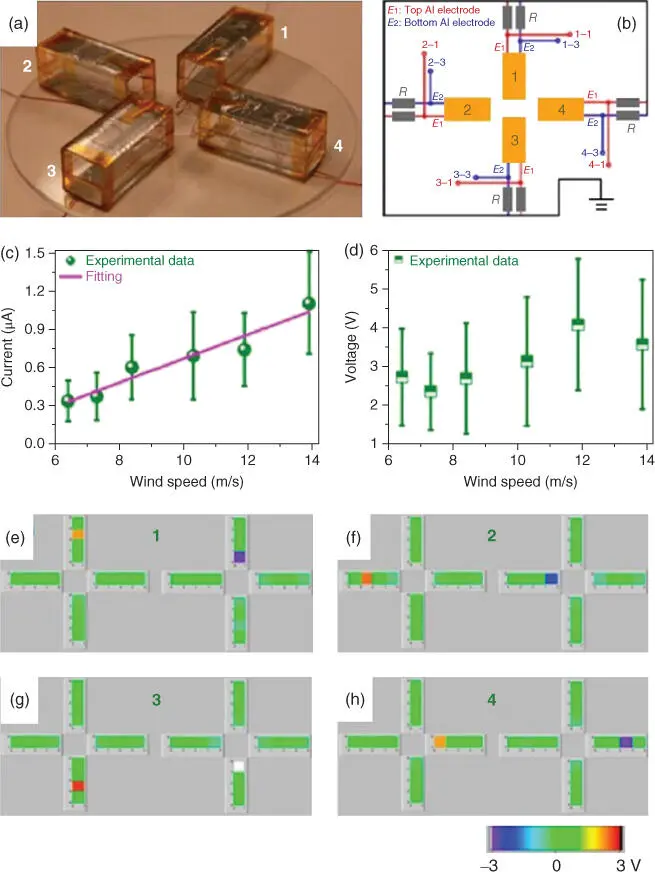
Figure 2.15The self‐powered wind vector sensor system. (a) Photograph of the four TENGs orientation. (b) Schematic diagram of the circuit. (c) Measured output current. (d) Measured output voltage. (e–h) Measured output voltage mapping figures for different wind directions.
Source: Reproduced with permission from Yang et al. [32]. Copyright 2013, American Chemical Society.
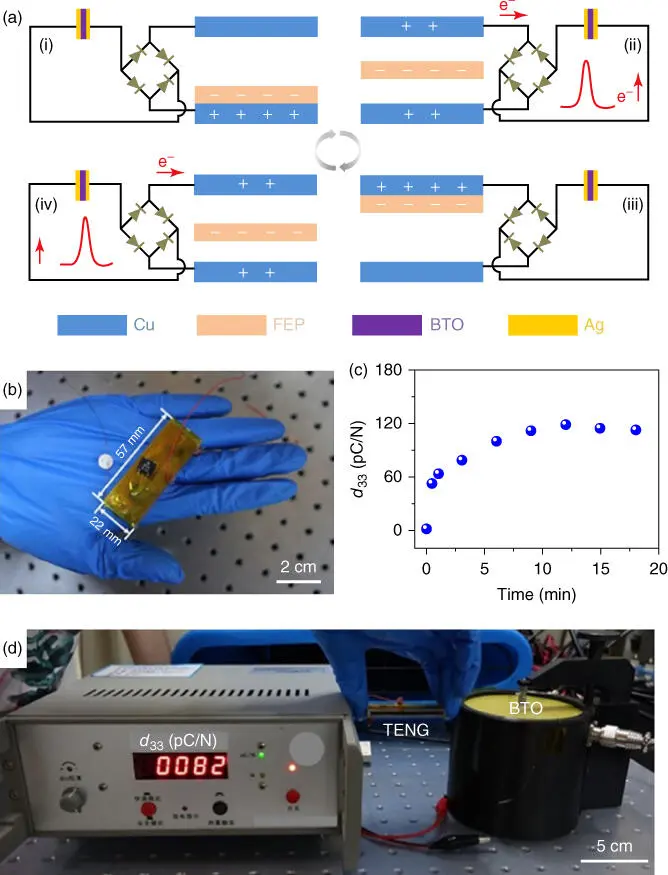
Figure 2.16The polarization system. (a) Schematic illustration of the working principle of the polarization system. (b) Photograph of the handheld TENG‐based polarization device. (c) Measured piezoelectric coefficient for different polarization times. (d) Photograph of the effective polarization result.
Читать дальшеИнтервал:
Закладка:
Похожие книги на «Hybridized and Coupled Nanogenerators»
Представляем Вашему вниманию похожие книги на «Hybridized and Coupled Nanogenerators» списком для выбора. Мы отобрали схожую по названию и смыслу литературу в надежде предоставить читателям больше вариантов отыскать новые, интересные, ещё непрочитанные произведения.
Обсуждение, отзывы о книге «Hybridized and Coupled Nanogenerators» и просто собственные мнения читателей. Оставьте ваши комментарии, напишите, что Вы думаете о произведении, его смысле или главных героях. Укажите что конкретно понравилось, а что нет, и почему Вы так считаете.
